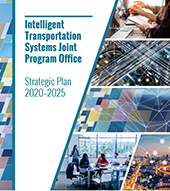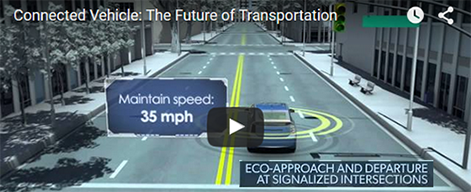Research Archive
Linking Technologies with Accessibility for Seniors and People with Disabilities
Slide 1. Linking Technologies with Accessibility for Seniors and People with Disabilities
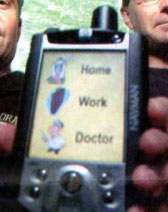
Barbara A. Sisson, P.E.
Associate Administrator for Research, Demonstration, and Innovation
Federal Transit Administration
United States Department of Transportation
11th ITS World Congress
October 20, 2004
Nagoya, Japan
Logos for Federal Transit Administration and Department of Transportation
Notes
- Good morning, ladies and gentlemen.
- I am pleased to be here in Japan this week to participate in the 11th ITS World Congress. Today, I would like to take a few minutes to discuss efforts in the United States on using technology to overcome the barriers to accessibility and provide mobility to people with disabilities and older adults.
- Over the last few years, the United States government has placed a new emphasis on mobility and accessibility for all. I look forward to sharing with you how the US DOT is doing in this area, and the ways that we are applying ITS and other advanced technologies to assist in providing accessibility and mobility to those that need it.
Slide 2
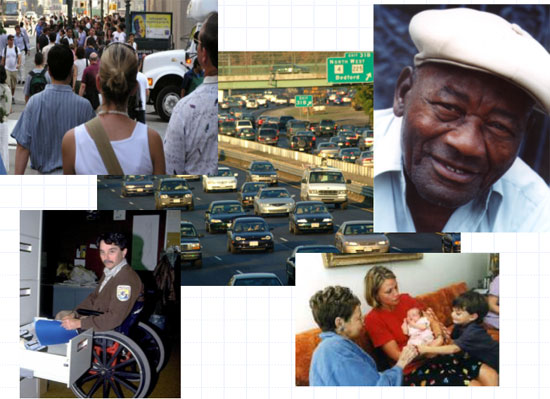
Notes
For most of us, how we will get to the doctor's office, a job, classes, or the grocery store is not something we worry about in our personal lives. Most of us hop in our cars to get to and from work, visit the doctor, go to the movies, or run errands. But for older adults, people with disabilities, and low-income families who can't afford or can't drive a car, these everyday activities are often out of reach.
In the United States…
One in every 10 households does not own a car…most because they simply can't afford one.
And one in every four Americans is an older adult or person with a disability – many of whom either cannot drive or cannot afford a car.
Slide 3. Background
- 62 Federal programs fund human services transportation
- $ Billions are spent on human services transportation
- FTA budget for public transportation is $7 billion
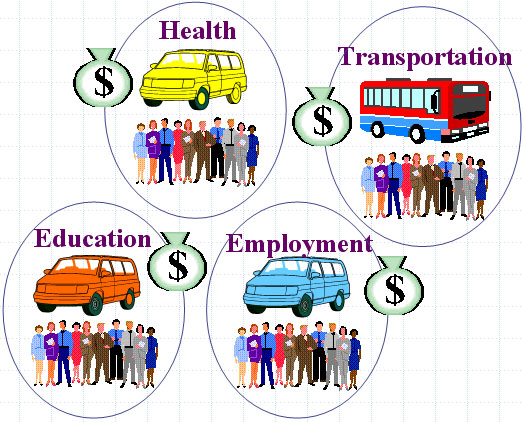
Notes
In the U.S., social service agencies' primary business is ensuring that their clients receive good services, including transportation. Historically, social service agencies have done an exceptional job, with a good deal of work being done internal to the agencies. And this is rightfully so since the agencies are the ones most concerned about their individual clients and their cases.
Currently, there are 62 Federal programs that fund transportation for human services, and billions of dollars are spent each year to provide human services transportation. The entire Federal Transit Administration budget for public transportation all across the country was around $7 billion in FY2003.
Now, we're hearing from these agencies and stakeholders that the traditional "stovepipe" approach to transportation service delivery not only is confusing to the customers, but also keeps agencies from operating efficiently. The fragmented approach to such fundamental services as transportation is costing more and delivering less. However, if we coordinate and use our funds more efficiently there should be plenty of resources available to address these issues. For example, a recent TCRP report showed that transit and human service agencies nationwide could derive annual benefits of up to $690 million through coordination.
Slide 4. Emphasis on Access For All
Two New USDOT-led Initiatives:
- United We Ride
- Mobility Services for All Americans
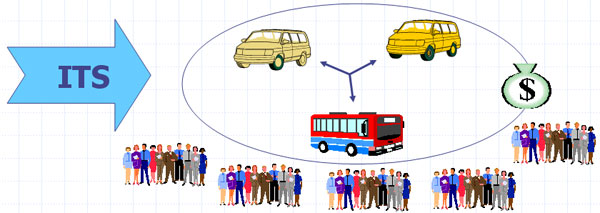
Notes
- Within the United States Federal Government there is a new emphasis on Access and Mobility for All.
- In 2001 President George W. Bush announced his commitment to "tearing down the remaining barriers to equality that face Americans with disabilities today" through his New Freedom Initiative. In 2004, this was followed by his Executive Order on Human Service Transportation Coordination. USDOT adopted Access and Mobility For All as a major goal in the new USDOT Strategic Plan of 2003–2008.
- A Federal Interagency Coordinating Council on Access and Mobility was created to guide the coordination, to convert the "stove pipe" model as shown in the previous slide into a coordinated human service transportation system.
- Some changes in legislation and in regulations are reinforcing this new emphasis. This includes the enactment of the Section 508 Accessible Information requirements, and shifts in the legal interpretation of the Americans with Disabilities Act requirements for accessible in-vehicle stop and other announcements.
- The US federal government launched two new efforts, both led by USDOT, to address this coordination issue: United We Ride and Mobility Services For All Americans. I will spend the next few minutes to discuss these two initiatives with you.
Slide 5. United We Ride
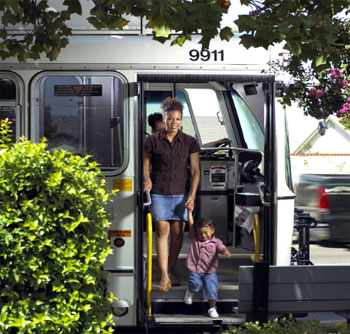
- Education & Outreach
- Consolidated Access
- Regulatory Barriers
- Coordinated Planning
- Cost Allocation
- Useful Practices
Notes
The interagency United We Ride Initiative is spearheading the coordination of transportation services. The Federal Interagency Coordinating Council on Access and Mobility adopted an action plan last month (September) that identifies and addresses the following six goal areas:
- Education and Outreach: the first goal is to develop an education plan for coordinated human service transportation resulting in enhanced customer access at the local level for individuals with disabilities; older adults; and individuals with lower incomes.
- Consolidated Access: the second goal is to simplify access to transportation services and to enhance customer service through the development of a comprehensive and coordinated transportation system. The ITS team plays a major role in leading this goal area.
- Regulatory Barriers: the third goal is to reduce restrictive and duplicative laws, regulations and programs related to human service transportation at the Federal level. As I have shared with you earlier, there are currently 62 federal human service programs that fund transportation.
- Coordinated Planning: the fourth goal is to enhance comprehensive planning for the coordination of human service transportation for the transportation disadvantaged.
- Cost Allocation: the fifth goal is to develop cost allocation models and methodologies, with the support of ITS technology, to standardize cost allocation process
- Useful Practices: the last, but not least, goal is to document successful strategies in coordinating human service transportation at the Federal, State, Tribal and Local levels.
Slide 6. United We Ride
- A Five-Part Initiative…
- A Framework for Action
- State Leadership Awards
- National Leadership Forum
- State Coordination Grants
- Help Along the Way

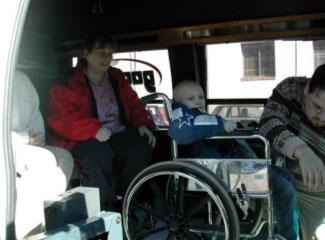
Notes
United We Ride is a 5 part initiative to Assist States and Communities in Coordinating Human Service Transportation:
- One is the implementation of a self-assessment tool that permits states and communities to evaluate where they are in achieving coordinated systems and what are the possible options for advancing more coordination within their communities.
- Two was to recognize states that had shown exceptional leadership in achieving coordinated human service transportation.
- Three was to hold a national meeting where four federal Departmental Secretaries invited governors to select high-level state teams to meet with federal officials in Washington, D.C. in late February 2004.
- Four is to work with states attending the National dialogue to develop commitments to next steps.
- Five is to provide additional small federal grants to help states and their communities to move forward by undertaking self assessments at the state level or appropriate next steps that result from the self assessment, and to provide technical assistance through FTA's existing technical assistance networks.
Slide 7. Making It Happen: Coordinated and Integrated ITS
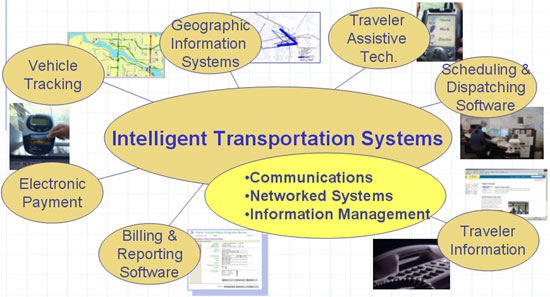
Notes
We believe that integrated ITS and Advanced Technologies have great potentials to assist in overcoming barriers and coordinating services are making accessible transportation happen. Some examples are:
- Geographic information systems assist in locating customers and providing fast and efficient routing for paratransit and other services.
- Vehicle Tracking and Scheduling and Dispatch Software provide for reduced call ahead times and improve scheduling. They also track vehicle locations in real time and help provide up-to-date information on when customers will be picked up and dropped off. They also assist in making coordinated transfers and ensuring that calls are met by other vehicles when something happens.
- Billing and reporting software: Uses data from the other ITS components to generate financial and client tracking reports; simplifies ridership reporting and invoicing.
- Traveler Information is also being made accessible by phone, the internet, and on the vehicle. Stops are automatically being called out, and information that accounts for accessible features in the built environment.
- Last new state-of-the-art assistive technologies that improve accessibility for seniors and persons with disabilities are helping people get to and from transit stops. These include talking signs, personal way finders and navigation aids.
These are all beginning to work together through Intelligent Transportation Systems using advanced communications, networked systems and information management to provide accessible door-to-door mobility to all.
Slide 8. Mobility Services For All Americans

Notes
Mobility Services for All Americans is a new U.S. DOT ITS Program Priority Initiative approved in 2004 to use technology to improve coordination and overcome barriers.
Its Goals are to use service coordination and technology integration to
- Increase mobility and transportation accessibility for the transportation disadvantaged and the general public
- Achieve more efficient use of federal transportation funding resources (i.e., provide more service with the same funding).
Its End Product will be a Replicable/Scalable Model Traveler Management Coordination Center (TMCC) that provides one-stop customer-based travel information and trip planning services, and coordinated transportation service operations.
In order to achieve this, the following five steps are essential:
- The first is building coalitions that include a DOT intermodal program team, an inter-agency coalition, and stakeholder advisory group/task forces. The goal is to make it not just a U.S. DOT initiative, but something shared by all.
- The second is working with and build upon United We Ride, and other Federal activities.
- The third is carrying out foundation research to understand the needs and barriers of the disabled and elderly commonalities that we are trying to serve, the issues and hurdles that must be overcome in order to serve them, and the technologies that now exist that can be used to address them.
- The fourth is selecting and implementing technology integration field operational tests.
- The last, a key, step is developing a scalable/replicable Traveler Management Coordination Center that brings it all together.
Slide 9. Thank You
Barbara A. Sisson, P.E
Associate Administrator for Research, Demonstration, and Innovation
Federal Transit Administration
United States Department of Transportation .
Phone: (202) 366-4052
E-mail: barbara.sisson@fta.dot.gov
Notes
Thank you, I want to leave you with contact information for your reference, and please feel free to contact me if you have any other questions.
Once again, thank you for allowing me to speak and share my thoughts on this very important topic and I hope you enjoy the rest of this exciting ITS World Congress Conference.


